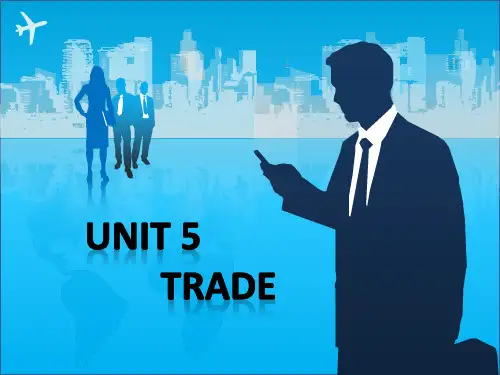新职业英语视听说教程(上册)教案
- 格式:docx
- 大小:4.28 MB
- 文档页数:20

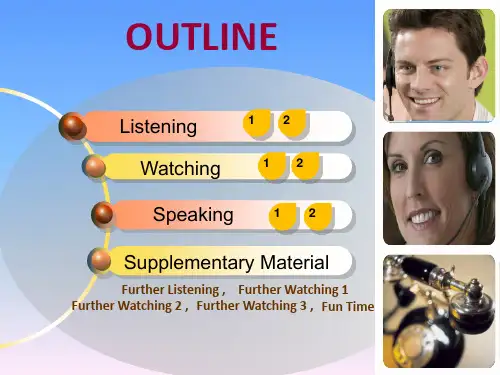
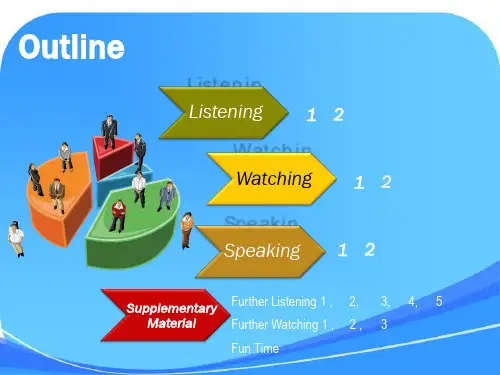
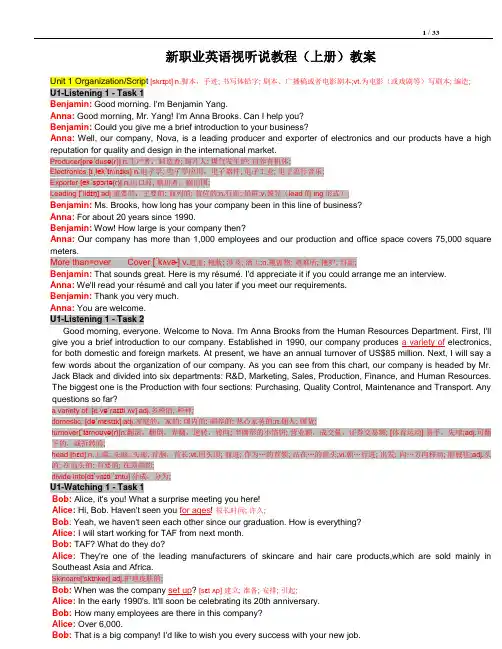
新职业英语视听说教程(上册)教案Unit 1 Organization/Script [skrɪpt]n.脚本,手迹; 书写体铅字; 剧本、广播稿或者电影剧本;vt.为电影(或戏剧等)写剧本; 编造;U1-Listening 1 - Task 1Benjamin: Good morning. I'm Benjamin Yang.Anna: Good morning, Mr. Yang! I'm Anna Brooks. Can I help you?Benjamin: Could you give me a brief introduction to your business?Anna: Well, our company, Nova, is a leading producer and exporter of electronics and our products have a high reputation for quality and design in the international market.Producer[prəˈdusə(r)] n.生产者,制造者; 制片人; 煤气发生炉; 自养有机体;Electronics [ɪˌlekˈtrɑnɪks]n.电子学; 电子学应用,电子器件; 电子工业; 电子流行音乐;Exporter [ekˈspɔrtə(r)] n.出口商; 输出者,输出国;Leading [ˈlidɪŋ]adj.重要的,主要的; 前列的; 首位的;n.行距; 铅框;v.领导(lead的ing形式);Benjamin: Ms. Brooks, how long has your company been in this line of business?Anna: For about 20 years since 1990.Benjamin: Wow! How large is your company then?Anna: Our company has more than 1,000 employees and our production and office space covers 75,000 square meters.More than=over Cover [ˈkʌvɚ]v.遮盖; 掩蔽; 涉及; 洒上;n.覆盖物; 避难所; 掩护; 封面;Benjamin: That sounds great. Here is my résumé. I'd appreciate it if you could arrange me an interview.Anna: We'll read your résumé and call you later if you meet our requirements.Benjamin: Thank you very much.Anna: You are welcome.U1-Listening 1 - Task 2Good morning, everyone. Welcome to Nova. I'm Anna Brooks from the Human Resources Department. First, I'll give you a brief introduction to our company. Established in 1990, our company produces a variety of electronics, for both domestic and foreign markets. At present, we have an annual turnover of US$85 million. Next, I will say a few words about the organization of our company. As you can see from this chart, our company is headed by Mr. Jack Black and divided into six departments: R&D, Marketing, Sales, Production, Finance, and Human Resources. The biggest one is the Production with four sections: Purchasing, Quality Control, Maintenance and Transport. Any questions so far?a variety of:[e vəˈraɪɪti ʌv]adj.多种的; 种种;domestic:[dəˈmɛstɪk]adj.家庭的,家的; 国内的; 驯养的; 热心家务的;n.佣人; 国货;turnover[ˈtɜrnoʊvə(r)]n.翻滚,翻倒,弄翻,逆转,转向; 半圆形的小馅饼; 营业额,成交量,证券交易额; [体育运动] 易手,失球;adj.可翻下的,或折转的;head [hɛd]n.上端; 头脑; 头部; 首脑,首长;vt.用头顶; 前进; 作为…的首领; 站在…的前头;vi.朝…行进; 出发; 向…方向移动; 船驶往;adj.头的; 在前头的; 首要的; 在顶端的;divide into[dɪˈvaɪd ˈɪntu]分成,分为;U1-Watching 1 - Task 1Bob: Alice, it's you! What a surprise meeting you here!Alice: Hi, Bob. Haven't seen you for ages! 很长时间; 许久;Bob: Yeah, we haven't seen each other since our graduation. How is everything?Alice: I will start working for TAF from next month.Bob: TAF? What do they do?Alice:They're one of the leading manufacturers of skincare and hair care products,which are sold mainly in Southeast Asia and Africa.Skincare['skɪnker] adj.护理皮肤的;Bob: When was the company set up? [sɛt ʌp] 建立; 准备; 安排; 引起;Alice: In the early 1990's. It'll soon be celebrating its 20th anniversary.Bob: How many employees are there in this company?Alice: Over 6,000.Bob: That is a big company! I'd like to wish you every success with your new job.Alice: Thank you! How about you, Bob? Do you still work for Otis Elevator?Bob: No, I've already left and started up my own business a year ago.Start up:[stɑrt ʌp](使)开始运转; 开始,着手;=runAlice: You're self-employed! That's marvelous! What line of business are you in?Self-employed:自营;个体经营的; self-service.marvelous [ˈmɑrvələs]adj.引起惊异的; 不可思议的; 非凡的; 神乎其神;Bob: I specialize in专攻,精通,以…为专业;专修importing and exporting chemical products.Alice: Fantastic! There might be chances for us to do business together.Bob: Definitely. This is my business card. Let's keep in touch.Alice: Sure.U1-Watching 1 - Task 2Alice: May I come in?Bill: Yes, come in, please.Alice: Good morning, Sir. My name is Alice Zhao. I'm a newcomer to Sales & Marketing Department.Newcomer [ˈnukʌmə(r)]n.新来的人; 新手; 新生事物;Bill:Good morning, Alice. Sit down, please. I'm Bill Smith, Manager of this department. Welcome to Sales & Marketing.Alice: Thank you, Mr. Smith.Bill: Just call me Bill. Have you reported to the Human Resources Department?Alice: Yes, Sir.Bill: Then, you've already got a brief introduction of our company?Alice: Yes, Mr. Smith. But I am a bit confused about the organizational structure.Bill: Well, it's not that complicated. Look at this organization chart.The company is headed by the Board of Directors董事会, which takes charge of company strategies and general policies. The Board usually appoints a CEO to take responsibilities for the company's daily operation.Complicate [ˈkɑmplɪkeɪt]vt.使复杂化; 使错综,使混乱; 使卷入; 变复杂;adj.复杂的; 麻烦的; (昆虫的翅)纵折的;Alice:Oh, I know Mr. Bruce Anderson is the CEO of our company. He was a business professor at a famous college before he joined our company.Bill: Yes. Our company is divided into five areas. They are: the R&D, the Sales & Marketing, the Production, the Finance, and the Human Resources.The biggest one is the Production Department. It has four sections: Purchasing, Quality Control, Transport and After-sales.Alice: What about our department then?Bill:Since our markets are mainly in Southeast Asia and Africa, our department is accordingly divided into two regional branches. Is that clear now?Accordingly[əˈkɔrdɪŋli]adv.因此,于是; 依据; 照着,相应地;Regional [ˈridʒənəl]adj.地区的,区域的; 特定区域的,特定地区的; 方言的; 区域性;Alice: Yes, very clear. Thank you.Unit 1 Organization / ScriptU1-Listening 2 - Task 1(Benjamin is chatting with another newcomer during the break.)Daphne: We have the Board of Directors, the CEO, and the shareholders. What are the differences between them? Shareholder [ˈʃerhoʊldə(r)]n.股东; 股票持有者;Benjamin: The shareholders own the company. They form the financial control system.Daphne: What does the CEO do?Benjamin: He is responsible for everything that happens in the company, acting as the official representative of the company. If there is only one person with absolute power in a company, everyone knows the power will go to the CEO.Act as[ækt æz]担当…,起…的作用; 充; 充当; 为;Representative[ˌrɛprɪˈzɛntətɪv]n.代表; 继任者; 议员; 类似物;adj.典型的; 有代表性的; 代议制的; 相当[类似](另一种属)的;Absolute [ˈæbsəˌlut]adj.绝对的,完全的; 不受任何限制[约束]的; 无条件的; 有无上权力或权威的;n.绝对; 绝对事物;Daphne: Isn't that too dangerous? Danerous adj. Danger n.Benjamin: You are right. That's the reason for having a Board of Directors. The Board is made up of a group of independent and unbiased people, to whom the CEO is responsible.Be made up of [bi med ʌp ʌv]由…组成;Independent [ˌɪndɪˈpɛndənt]adj.自主的; 不相关连的; 无党派的; 不相干的人所做的(或提供的);n.独立自主的人; 无党派人士;Unbiased [ʌnˈbaɪəst]adj.无偏见的,不偏不倚的,公正的; 持平; 无偏无党; 谠;Daphne: What does the Board of Directors do?Benjamin: They meet monthly, quarterly, or annually, providing long-term planning and vision, and acting as moralBenjamin: Yes, all the departments involved are busy with it now.Daphne: What departments are involved?Benjamin: Three departments: R&D, Production and Quality Control.Daphne: Teamwork again. How do they cooperate with each other?Benjamin: First, the R&D designs new products. The keyword in this phase is innovation.Daphne: Yes, that's why it takes a lot of effort, too.Benjamin:Then the Production comes in. As soon as the design proves feasible, the Production starts the assembly line and puts the design into real products.Feasible [ˈfizəbəl]adj.可行的; 可用的; 可实行的; 可能的;Daphne: How does the Quality Control collaborate with the other two?Collaborate [kəˈlæbəˌret]vi.合作,协作; (国家间的)协调,提携; 勾结,通敌; =cooperateCollaborate with[kəˈlæbəˌret wɪð]v.合作,与敌人合作,通敌;Benjamin: The QC takes random samples up to the lab for testing. Manufacturing problems are reported to the Production and design problems go to the R&D.Random [ˈrændəm]adj.任意的; 随机的; 胡乱的;n.随意; 偶然的行动;Daphne: I can see close cooperation among the three is the key to product quality.Benjamin: You're right.U1-Watching 2 - Task 1Bill: My name is Bill Smith. I'm the manager of Sales and Marketing at TAF. I'm responsible for sales and promotion of the company's products. Today I'm going to introduce to you my colleagues around the company. Here is my colleague, Alice. Today is actually her second day in our company and she's going to help me with this video. Come on, Alice! Here is Victoria. Hi, Vicky!Victoria: Hello, Bill.Bill: Please Vicky... Could you just give your name, your job title and a description of what you do?Victoria: Oh, is this for next week's trade fair? 商品交易会;Bill: Yes, we need to briefly introduce our company at the trade fair.Victoria: OK. Is your camera ready? My name is Victoria Song. I'm an assistant manager for international PR. I establish and maintain relationships with our overseas partners. PR(public relations)Bill: Thanks, Vicky... This is Dave, Manager of the Production Department. Hi,Dave!Dave: Hi, Bill. How's the preparation for the trade fair going?Bill: Actually, I'm working on it right now! Could you give your name, your title and a description of what you do? Dave:Sure. Hello, I am Dave from the Production Department. We are responsible for developing and manufacturing products.Bill: Thanks, Dave.U1-Watching 2 - Task 2Bill: Hi, Alice, how is it going so far?Alice:So far so good. Everything's interesting, except that n.除了…之外,只可惜the set-up here is still a little confusing—who's where and what's what.Bill: I see. Let me show you around and tell you how the company operates.Alice: You are always so nice!Bill: This way, please. Right there at the far end of the corridor on the right is the CEO's office. Have you met Mr.Alice: Not yet.Bill: Next to the photocopy room is the Finance Department. If you have any questions concerning your payment, you can come here.Concern [kənˈsɜrn]vt.涉及,关系到; 使关心,使担忧; 参与;n.关心; 关系,有关; 顾虑; 公司或企业;Alice: Payments for our products are handled here too, I guess.Bill: Yes. They offer us statistics about our sales performance as well. Opposite the Finance Department is the R&D Department. Requests and complaints from our clients shall be forwarded to them.Statistic[stəˈtɪstɪk]n.统计资料中的一项; 统计数据;统计量;(对总体具有代表性的)典型统计论;adj.统计(上)的,统计学(上)的;Alice: So, we'll cooperate a lot with the R&D.Bill: Right. Another department we often work with is the Production Department, next to the R&D. Orders from our clients will go to them.Alice: Are they responsible for dispatching and maintenance?Dispatch [dɪˈspætʃ]vt.派遣,调度; (迅速地)发出; 迅速处理,迅速了结; 处决(罪犯等);n.(使者等的)派遣; 急件; 迅速办理,快速处理; (记者发回的)新闻报道;Bill: Yes. The Transport Section and the After-sales Section handle those responsibilities.Alice: Thank you very much, Bill.Bill: By the way, if you have any trouble with your work, you can come to me. I'm the first person you can turn to for help. Turn to[tɚn tu](使)转向; (使)变成; 求助于; 翻书到;Unit 1 Organization / ScriptU1-Supplementary Listening - Task 1A: Where is H&M located?B: It's located in Texas, USA.A: How far is H&M from Scavo Town?B: It's about 70 km south of Scavo.A: What does the company produce?B: It produces tires. tire[taɪr]vt.使…疲惫; 使…厌烦;vi.厌烦; 疲劳;n.轮胎; 头饰; tie[taɪ]领带A: When was the company founded?B: It was founded in 1983.A:How many people work for H&M?B: More than 2,000 people work for it.U1-Supplementary Listening - Task 2A: My name is James Wilson, Business Manager of Sunshine Ltd. I've been with the company for nearly 11 years.It's my pleasure to introduce our company to you.B: Thank you, Mr. Wilson. Would you please tell me where your company is based?A: It is based in Dongguan, Guangdong Province, fairly central to the Pearl River Delta and close to Guangzhou.Fair[fer]adj.公平的; 合理的; 晴朗的; 美丽的;adv.公平地; 直接地; 清楚地; 正大光明地;n.集市,庙会; 商品交易会,展览会; 美人,美丽的事物;vt.(卡通制作)顺利接合; (动作)衔接协调; (飞机)装配平整; 使(飞机接合部)平滑;vi.转晴;Fairly [ˈferli]adv.适当,相当地; 公平地; 完全,简直; 清楚地;B: Oh, very good transport links. When was your company founded?Link [lɪŋk]n.环,节; [计算机]链接; 关联,关系;vt.连结; 挽住,勾住;vi.用环连接; 联系在一起;A: It was founded in 1983.B: What does your company mainly produce?A: Our main products are tires for cars and trucks, which are sold to countries and regions all over the world.B: Your company is doing a great job in this field. Thank you for giving me such a detailed introduction.U1-Supplementary Listening - Task 3When you walk through the main gate, you will see a neat, 4-storeyed building about 50 meters away. That is our Neat[nit]adj.整洁的,干净的; 灵巧的; 匀整的; 未搀水的; 4-storeyed:4层楼的office building where all executive departments are located. To the left of the office building is a workshop with five floors. The assembly line is on the first two floors. There, our workers are busy producing quality tires around the clock. There are two warehouses at the back of the workshop. One is for raw materials, and the other is for finished products. Beside the warehouses is a small building where maintenance staff work. They will be on the spot immediately if any machine breaks down. The yellow building on the right side of the office building is our canteen. It can cater for 2,000 people at the same time.on the spot :[ɑn ði spɑt]立刻; 当场; 在危险中; 处于负责地位;cater [ˈketɚ]vt.& vi.提供饮食及服务;vt.满足需要,适合; 投合,迎合;n.(骰子,纸牌的)四点;cater for [ˈketɚ fɔr]提供饮食及服务; 迎合;U1-Supplementary Listening - Task 4Our company specializes in organizing cultural events and language courses. With 40 employees, it is small in size, but quite complete in structure. The Managing Director is in charge of the whole organization including four departments: Science, English Language, Arts and Finance. The department managers report to the Managing Director总经理 directly. The English Language Department has two sections. One is the Cultural Section, dealing with various cultural events related to English, and the other is the Examination Section, where language exams and courses are set up. The Arts Department also has two sections—the Exhibition Section and the Library. The Finance Department is mainly responsible for managing company accounts and paying salaries. As our company is quite small, we don't have a team leader in each section but everyone works hard.U1-Supplementary Listening - Task 5A: Good morning, Mr. Lee. I'm Helen Grey. I'd like to give you a general picture of our company structure.General [ˈdʒɛnərəl]adj.大致的; 综合的; 总的,全体的; 普遍的;n.上将; 一般; 一般原则; 常规;B: Thank you, Ms. Grey.A: First, we have a Board of Directors. Philip Dickson is the Chairman, and Anne Roberts is the Managing Director, who reports directly to Mr. Dickson.B: How many departments are there in the company?A:Four in all: Production, Marketing, Finance and Personnel. David Peters is the Production Manager, Fiona Harris is the Marketing Manager, and Mark Taylor, head of the Finance.Personnel [ˌpɜrsəˈnel]n.全体员工; (与复数动词连用)人员,员工; 人事部门;B: How about the Personnel Department?A:Led(lead的过去式和过去分词) by Nina Smith, the Department has two sections: Recruitment[rɪˈkrutmənt]and Training. Paul Rees is the Recruitment Manager and I am responsible for training. LedB: Oh, I see. Thank you very much, Ms. Grey.A: My pleasure. Hope you enjoy working here.Unit 2 Office / ScriptU2-Listening 1 - Task 1Jack: Well, Mr. Anderson, I was wondering if I could come and meet you at 3 p.m. next Monday.Bruce: Sorry, Mr. Black. I am afraid I have another appointment at that time.Jack: Then how about next Tuesday?Bruce: I am afraid I might be attending an opening ceremony in the morning and going to a conference in the afternoon. May be=maybeCeremony [ˈserəmoʊni]n.典礼,仪式; 礼仪,礼节; 虚礼,客气;Jack: Is Wednesday OK for you?Bruce: I'll be leaving for Shanghai next Wednesday and probably won't be back until Friday afternoon. Look, why don't I call you back and set the time later? Leave for 而不是leave toJack: OK, let me tell you my telephone number.Bruce: Oh, I have already got your number.Jack: Good, when can I expect your call then?Bruce: Maybe in a week or so. 大约; 左右; 把;Jack: I'll look forward to your call.U2-Listening 1 - Task 2Bill:Alice, have you found the files I asked for? Mr. Anderson needs those files before his meeting with Jack Black.Alice: Sorry, Bill. I couldn't find any information on Jack Black. Maybe we don't have the files in our department. Bill: I am quite sure that the information was filed. Do you know we use the alphabetical filing system?我很确定信息是归档的。
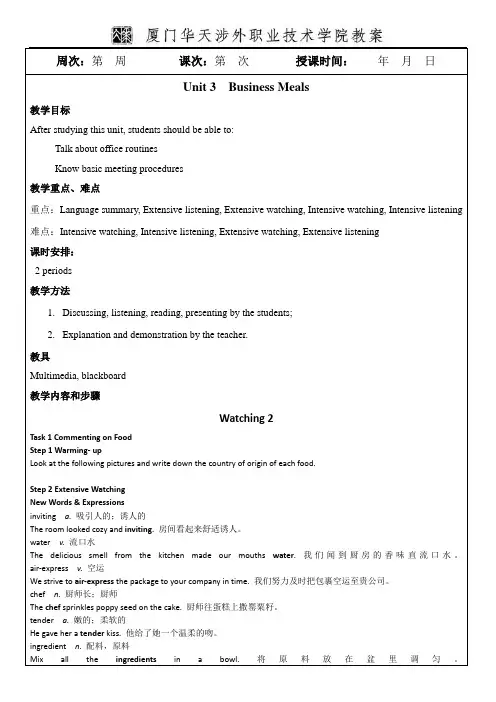
周次:第周课次:第次授课时间:年月日Unit 3 Business Meals教学目标After studying this unit, students should be able to:Talk about office routinesKnow basic meeting procedures教学重点、难点重点:Language summary, Extensive listening, Extensive watching, Intensive watching, Intensive listening 难点:Intensive watching, Intensive listening, Extensive watching, Extensive listening课时安排:2 periods教学方法1.Discussing, listening, reading, presenting by the students;2.Explanation and demonstration by the teacher.教具Multimedia, blackboard教学内容和步骤Watching 2Task 1 Commenting on FoodStep 1 Warming- upLook at the following pictures and write down the country of origin of each food.Step 2 Extensive WatchingNew Words & Expressionsinviting a.吸引人的;诱人的The room looked cozy and inviting. 房间看起来舒适诱人。
water v.流口水The delicious smell from the kitchen made our mouths water. 我们闻到厨房的香味直流口水。



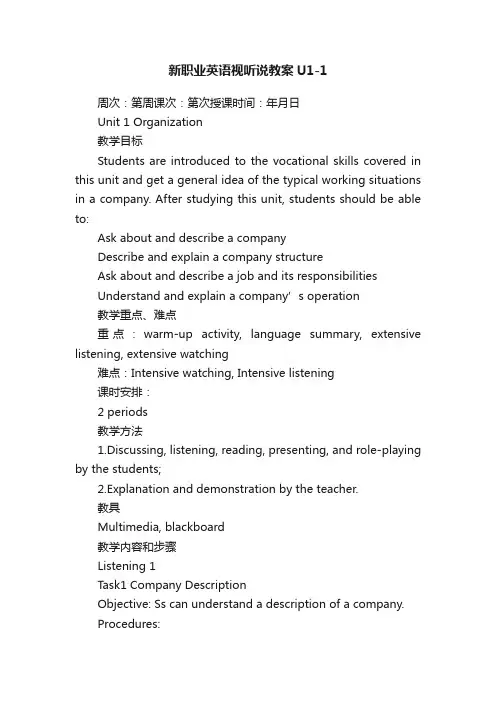
新职业英语视听说教案U1-1周次:第周课次:第次授课时间:年月日Unit 1 Organization教学目标Students are introduced to the vocational skills covered in this unit and get a general idea of the typical working situations in a company. After studying this unit, students should be able to:Ask about and describe a companyDescribe and explain a company structureAsk about and describe a job and its responsibilitiesUnderstand and explain a company’s operation教学重点、难点重点:warm-up activity, language summary, extensive listening, extensive watching难点:Intensive watching, Intensive listening课时安排:2 periods教学方法1.Discussing, listening, reading, presenting, and role-playing by the students;2.Explanation and demonstration by the teacher.教具Multimedia, blackboard教学内容和步骤Listening 1Task1 Company DescriptionObjective: Ss can understand a description of a company.Procedures:S tep1: Ss get prepared for the conversation of company description by finishing Warming-up.Step2: Ss listen to the conversation extensively to get a global understanding. Check Ss’ comprehension by finishing Extensive ListeningStep3: Ss listen to the conversation intensively to get a detailed understanding. Check Ss’ comprehension by finishing Intensive ListeningStep4: Ss review expressions concerning company description in Language SummaryTask 2 Company StructureObjective: Ss can understand a description and explanation of a company structureProcedures:S tep1: Ss complete the crossword puzzle to form words that relate to departments in a company. Provide more related words.Step2: Ss listen to a speech by Anna Brooks and tick the correct answer to each questionStep3: Ss listen to the conversation again and complete the organizational structure of the company. Watching 1 Task 1 Company DescriptionObjective:Ss can learn the skills of asking about and describing a companyProcedures:S tep1: Warming-upSuppose you come across an old friend you’ve not swwn for some time. How do you greet each other?Step2: Ss watch a video clip and match the names with the related information.Step3: Ss watch a video clip again and complete the form..Step4: Ss review the sentences describing a company in Language Summary.Task 2 Company StructureObjective:Ss can learn the skills of describing and explaining a company structure.S tep1: Warming-upSuppose you have got a part time job. How would you greet your manager on your first day at work?Step2: Ss watch a video clip and tick those that are covered in the talk.Step3: Ss watch a video clip again and answer the related questions..Step4: Ss compare the words and expressions in Language Summary.Speaking 1Objective: This part aims at guiding Ss to practice the skills they’ve learned in Listening1 and Watching 1. ? Step1: Ss work in pairs. Complete and practice conversation.Step2: Ss work in pairs. Role-play a conversation.Step3: Ss work in pairs. Make sentences with the help of the tips.Step4: Ss work in pairs. Suppose they work in the HR Department of a company. Practice introducing your company organization to a new staff member.课后作业:Finish the rest part of correspinding exercise课后小结:周次:第周课次:第次授课时间:年月日Unit 1 Organization教学目标Students are introduced to the vocational skills covered in this unit and get a general idea of the typical working situations in a company. After studying this unit, students should be able to:Ask about and describe a companyDescribe and explain a company structureAsk about and describe a job and its responsibilitiesUnderstand a nd explain a company’s operation教学重点、难点重点:warm-up activity, language summary, extensive listening, extensive watching难点:Intensive watching, Intensive listening课时安排:2 periods教学方法3.Discussing, listening, reading, presenting, and role-playing by the students;4.Explanation and demonstration by the teacher.教具Multimedia, blackboard教学内容和步骤Listening 2Task1 Job DutyObjective: Ss can understand a description of a job and its responsibilities.Procedures:S tep1: Ss learn some abbreviations for some positions by finishing Warming-up.Step2: Ss listen and match the responsibilities in the right column with the person in the left column according to the conversation.Step3: Ss listen to the conversation intensively and fill in the blanks with proper words.Step4: Ss fill in the blanks with proper words.Task 2 Company OperationObjective: Ss can understand an explanation of a company’s operation.Procedures:S tep1: Suppose you are the CEO of a company. Which department will you forward each of the following problems to?Step2: Ss listen to a conversation between Benjamin and Daphne and tick the correct answer to each question Step3: Ss listen to the conversation again and complete the related questions.Step4: Sentences review.Watching 2Task 1 Job DutyObjective:Ss can learn the skills of asking about and describing a job and its responsibilities.Procedures:S tep1: Ss work in pairs. Write down proper department names according to the description.Step2: Ss watch a video clip and match the people with their title.Step3: Ss watch a video clip again and decide whether the statements are true or false.Step4: Ss write a sentence describing responsibilities of acertain job following the examples given.Task 2 Company OperationObjective:Ss can learn the skills of describing and explaining a company’s operation.S tep1: Ss work in pairs and brainstorm as many words or phrases as possible that can be used to describe positions Step2: Ss watch a video clip and tick those departments that they’ve mentioned.Step3: Ss watch a video clip again and decide whether the statements are true or false.Step4: Sssentences in Language Summary.Speaking 2Objective: This part aims at guiding Ss to practice the skills they’ve learned in Listening 2 and Watching 2. ? Step1: Ss work in pairs. Complete and practice conversation.Step2: Ss work in pairs. Make up a conversation.Step3: Ss work in pairs. Put each step of the production process into the correct place on the flowchart anddescribe the whole process to your partner in full sentences.Step4: Ss work in pairs. Work out a flow chart for a company and show its ordering, manufactureing and dispatch system.课后作业:Finish the rest part of corresponding exercise课后小结:。

